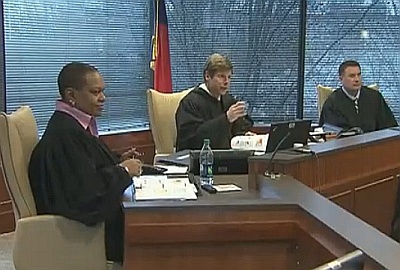More questions in NC redistricting case

By Sharon McCloskey, NC Policy Watch
After two full days of hearings in February, and a request in early April for additional argument from counsel regarding evidence, the three-judge panel hearing the redistricting case called the attorneys together for a conference late Wednesday to discuss a few remaining questions to be considered before the court could rule on the parties' separate requests for judgment in their favor.
The cases, Dickson v. Rucho and North Carolina State Conference of Branches of the NAACP v. North Carolina (now consolidated), have been pending since late 2011 after the General Assembly gave final approval to redistricting plans. Plaintiffs, a collection of individual voters and organizations, contend that Republican lawmakers secretly drafted the plans in a way that diluted the African-American vote in several districts across the state.
The judges acknowledged the importance of the case and stressed that they were carefully reviewing both side's claims, according to Edwin Speas, an attorney for the plaintiffs. They indicated that they were making progress towards a decision, he added, but had a few points that were troubling them and wanted the parties' input as to evidence -- two in particular:
First, was there racially polarized voting -- i.e. were black voters in the minority in a district and unable to elect candidates of their choice -- sufficient to justify the creation of the new districts the Republicans drew?
And second, in certain districts (Senate 31 and 32, House 51 and 54, Congressional 4 and 12) where a majority black voting population was not achieved during redistricting, was there additional evidence that race nonetheless was the predominant factor in drawing those districts?
Counsel for the parties have until Friday to advise the court whether they believe additional evidence, and additional hearing dates, are needed.
* * *
In their complaints, plaintiffs contend that Sen. Bob Rucho and Rep. David Lewis, as chairs of the Senate and House redistricting committees, sought little input from other legislators and members of the general public, instead directing the drafting of redistricting maps with help from veteran Republican mapmaker Tom Hofeller.
Rucho and Lewis directed Hofeller to create majority black voting districts where possible across the state, plaintiffs say, pulling black voters out of their prior districts and packing them into new ones and splitting precincts within districts in unprecedented numbers, at times drawing lines which divided even single family homes and apartment complexes. The result was whiter and more Republican-leaning districts elsewhere.
But defendants say that the maps were drawn to comply with the state constitution's "whole county provision," which provides that counties not be divided when creating a voting district except to the extent required by federal law.
And they claim that the Voting Rights Act required them to create those districts in order to provide black voters with a roughly proportional and equal opportunity to elect their candidates.
"We do not think it's a racial gerrymander to draw a 50 percent district," said Tom Farr, one of the attorneys representing Rucho and Lewis, during arguments in February. "It's not a racial gerrymander to draw districts with a consciousness of race. If that were true, your honors, all of these districts would be racial gerrymanders."
But plaintiffs countered that drawing such a district is in fact gerrymandering if it's not needed to comply with the Act. Such a district has to be drawn to create voting opportunity where it does not already exist -- where, as the U.S. Supreme Court said in its 2009 Bartlett v. Strickland decision concerning the last go-round of North Carolina redistricting litigation, the majority is voting "sufficiently as a bloc . . . to defeat the minority's preferred candidate."
That simply was not the case in many of the districts redrawn by the Republican-controlled legislature in 2011, argued Edwin Speas and Anita Earls, attorneys for the plaintiffs. Instead of creating minority opportunity where it did not exist, the mapmakers drew districts where opportunity had been flourishing -- where black voters, though the minority, had been consistently electing their candidates of choice -- and simply added more, pulling black voters across precinct, district and county lines to reach that 50 percent mark and beyond, up as high as 57 percent, and leaving whiter districts in their wake.
* * *
The importance of the court's decision to voters here is obvious, but others across the country are also watching and waiting, as the 2011 redistricting process has drawn national scrutiny. Atlantic Monthly profiled the architect of the plans, Tom Hofeller, in an essay entitled "The League of Dangerous Mapmakers." ProPublica detailed the backroom map-drafting taking place at state GOP headquarters, at times at the behest of Art Pope, in its story "How Dark Money Helped Republicans Hold the House and Hurt Voters." And in a New York Times article headlined "The Great Gerrymander of 2012," a Princeton professor called the results of the state's 2012 congressional house vote, which went 51 percent Democratic, 49 percent Republican but yielded a delegation of only four Democrats and nine Republicans, statistically unlikely had districts been fairly drawn.
That apparent unfairness, along with a voting public tiring of the seemingly endless cycle of redistricting and litigation here, has also reignited calls for reform by legislators on both sides of the aisle.
In April, a bipartisan group filed House Bill 606, which would vest some responsibility for redistricting in an independent advisory commission selected by members of both parties, with ultimate approval authority remaining with the legislature. That bill remains in the committee on elections.
Tags
NC Policy Watch
A project of the N.C. Justice Center, N.C. Policy Watch is a news and commentary outlet dedicated to informing the public and elected officials as they debate important issues and to improving the quality of life for all North Carolinians.
